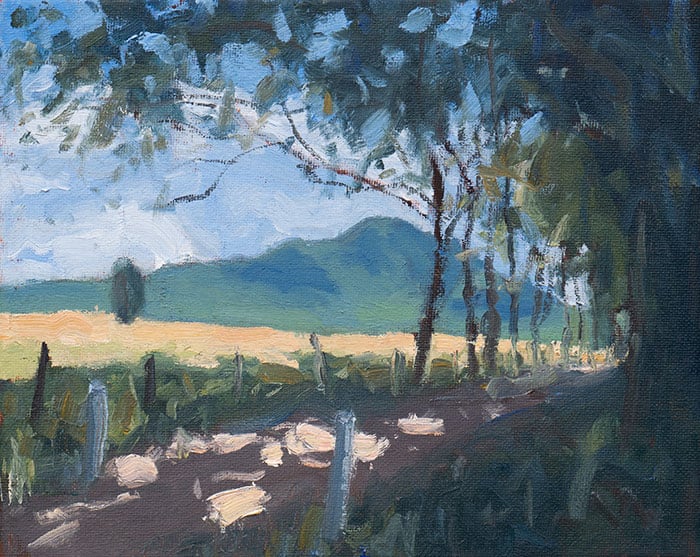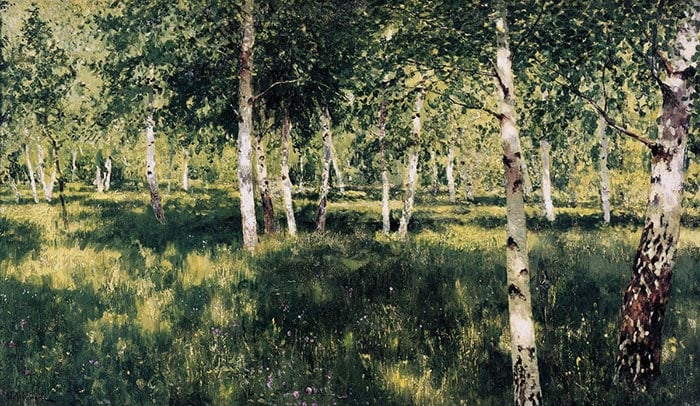light through tree effect drawing
Dappled light refers to that spotted light that typically comes through gaps in a tree canopy. Below is a great example by Claude Monet-notice the spots of light orange amongst the dark purple shadows.

In this post, I cover:
- More Examples of Dappled Light
- Tips for Using Dappled Light in Your Paintings
- Thanks for Reading!
The shapes created by the dappled light vary based on:
- The position of the sun;
- The height of the tree canopy;
- The shapes of the gaps which light is coming through (which tend to change frequently with the wind); and
- The plane where the light is hitting.
The shapes are also elliptical in nature, meaning they elongate as they get further into the distance.
Below is a photo of what dappled light looks like in life, along with a close-up. This was taken on a clear day, late in the morning. Warm, dappled light was shooting through the gaps in the leaves on the right-hand side.

Another important observation is the soft gradation between light and shadow. You can see this clearly in the close-up below.

More Examples of Dappled Light
Below are some more examples, starting with another painting by Claude Monet featuring dense trees and dappled light hitting the rough ground. In this case, Monet appears to have scumbled thick and saturated color over a dark foundation of greens and reds. Also, notice how the dappled light roughly follows the contour in the land.

Ilya Repin's, Alley in the Park, Kachanivka, is a great example of using dappled light to link two areas: the shadowed path under the tree canopy and the light area in the distance behind the person. Notice how the color used for the dappled light on the path is the same as the color used in the light area. Also notice how the clusters of dappled light get smaller as it moves into the distance, adding a sense of perspective to the painting.

My study below of Mount Barney is another example of using dappled light to link two areas: the shadowed path and the high-key background.

The painting below by Isaac Levitan features dappled light on long, irregular grass. Notice how some tall strands of grass and flowers are picking up light and appear to be intruding on the shadows. This creates an interesting and subtle overlap between light and shadow.
Tip: If you are creating an overlap between light and shadow like Levitan did below, make sure you don't overdo it. Otherwise, you risk compromising the integrity of your shadows.

Below is an example of dappled light painted with watercolors by John Singer Sargent, appropriately namedCorfu. Light and Shadows. An important observation is how Sargent used different colors for the shadows for each plane of the building: light purple/blue for the verticle plane on the right-hand side, warm purple for the left plane, and rich blue for the top plane.

Birthday Teacher (below) features a remarkably complex scene depicting a teacher and students having morning tea, all basked under dappled light.

The painting below is much calmer in comparison to Birthday Teacher above. It depicts two ladies sitting at the table, amongst the buildings and nature. Warm, dappled light is scattered throughout the scene. Observe the warm/cool relationship between the dappled light and shadow.
Tip: A useful exercise when analyzing paintings is to consider where the main light source is coming from (being the sun in this painting). In this case, the sun seems to be overhead to the right, perhaps behind the artist. This is because the light is hitting the right-hand side of the tree. The dappled light which is hitting the wall also appears to be slanting upward to the right, suggesting the position of the sun.

Tips for Using Dappled Light in Your Paintings
Here are some general tips for using dappled light in your paintings:
- If you want to paint realistically, then try picking up the gradual shift between light and dark.
- It can be highly effective to contrast thick paint and warm colors for the dappled light against thin paint and cool colors for the shadows. This creates a striking contrast between light and dark.
- Leave your colors slightly unmixed on your brush when painting dappled light. This will give your strokes an interesting multicolored effect which mimics the appearance of light in nature.

Thanks for Reading!
Thanks for taking the time to read this post. I appreciate it! Feel free to share with friends. If you want more painting tips, check out my Painting Academy course.
Happy painting!

Dan Scott
Draw Paint Academy
Source: https://drawpaintacademy.com/dappled-light/
0 Response to "light through tree effect drawing"
Post a Comment